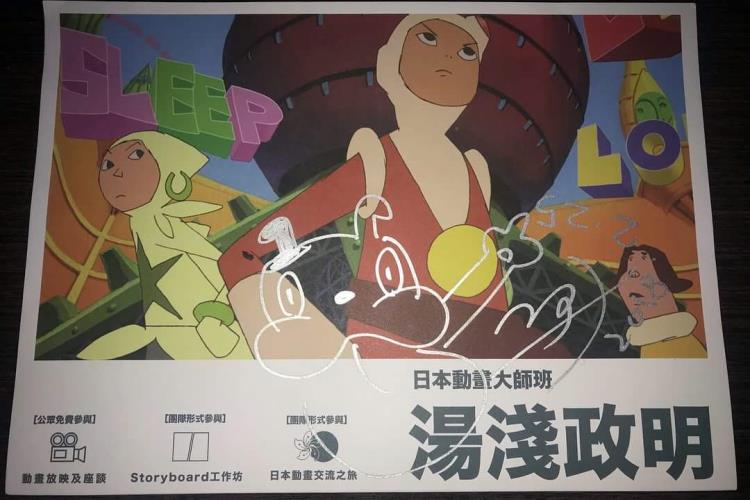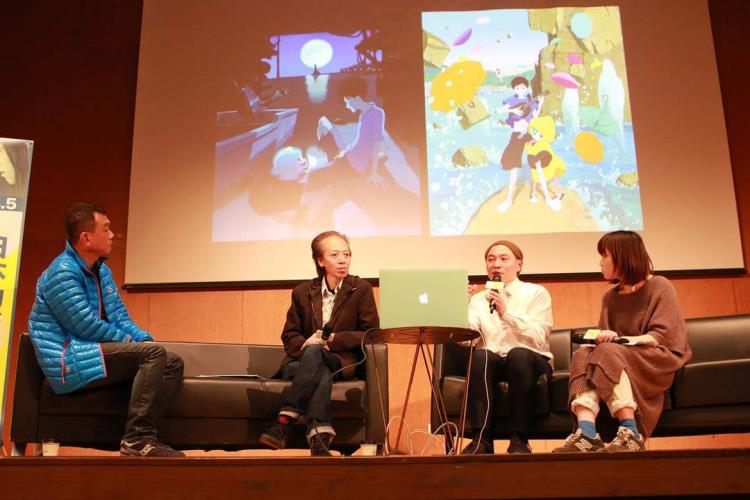Lo is an experienced anime producer and began independent anime creation in 1977. His works won the first prize at the Hong Kong Independent Short Film Festival for four consecutive times and he was promoted as panel member. In the next year, he joined the Radio Television Hong Kong to work as cartoon producer until 1993. Over recent years, he spent efforts on promotion of the anime industry in Hong Kong and planning of anime exhibitions. Recently, he worked as the curator of the 50 Years of Hong Kong and Taiwanese Animation. He currently worked as Secretary General of the Hong Kong Animation and Culture Association.

The Film Culture Centre of Hong Kong invited Masaaki Yuasa to give a talk at the Japanese Animation Masterclass recently
People who are passionate about Japanese anime must be familiar with the name Masaaki Yuasa. To some people, Masaaki Yuasa is actually the representative of alternative anime in Japan. Since Mind Game launched in 2004, Yuasa has been regarded as the rising star in the Japanese anime world, highly praised for his unique storytelling approaches and his wild visualisation skill. There is no exaggeration to describe his style as wild, which is apparent from his portrayal of the escape from a big whale’s mouth scene. A scene that is generally delivered through a few shots would last for minutes in the hands of Masaaki Yuasa. His storytelling approach is unpredictable and creative. However, Yuasa did not get himself into the mainstream anime industry in Japan after Mind Game but rather sticks to making productions he likes. After making several small productions, Yuasa adapted Tomihiko Morimi’s bestselling novel into a TV animation series, which became a huge hit, garnering high praises from the fans of the novel and the general anime audience. In 2014, Yuasa’s adaptation of Taiyō Matsumoto’s Ping Pong impressed the audience with its high quality as the adaptation maintains the essence of the original work while achieving visual aesthetics in animation. Since then, Yuasa has been considered as the most anticipated creator in the anime industry in Japan.
Last year has been a fruitful year for Yuasa. In 12 months, he produced two animated feature films and one anime episode, they are The Night is Short, Walk on Girl, Lu Over the Wall, and Devilman Crybaby for Netflix. The three productions have different styles and were well received by the audience. Lu Over the Wall even harvested a Crystal Award at the Annecy International Animation Film Festival, which is the highest honour in the anime industry. It’s apparent that Yuasa has earned the recognition and respect of the world.
On February 24th this year, Yuasa visited Hong Kong for the first time, giving a speech at The Open University of Hong Kong to an audience of around 400, which includes students studying animation and professional talents from the industry. The event was organised by the Film Culture Centre of Hong Kong and I was privileged to be the event host. Therefore I grab the chance to share more Yuasa’s stories in the short one hour. Before the event, I had come up with a few important questions, which involved Yuasa’s creativity and inspiration, as well as his approaches in adaptation and his use of Flash in producing animated feature films. Luckily, all these questions were answered by Yuasa.

Masaaki Yuasa (second from the right) interacted with participants
Yuasa’s animation presentation is shown in a unique way, through different shots from different angles. For instance, Yuasa adopts fisheye lens and angle like shooting on a table level. According to Yuasa, he learned these from movies and observation in life. It’s surprising that Yuasa doesn’t really watch manga or anime himself. In comparison, he likes a lot of movie directors, such as Brian de Palma from the U.S. Yuasa can talk for hours on Brian’s use of shots and lens in several movies and how Brian had inspired his production.
For a long time, Yuasa’s production has been focusing on adaptations, which have all been incredibly successful. To ensure the quality of the adaptations, Yuasa always reads the original works from the reader’s perspective first. Through this, he is able to identify the most exciting scenes and tries his best to keep them in the adaptations. On the other hand, he would also pay attention to the characters and storylines that have the potential to be further developed. Then he would use his own imagination and produce the best animation he can. Another important approach for Yuasa is that he would make the scenes more dynamic even if it’s just a scene of long dialogues in the original work. At the end of the day, we are talking about animations here. An animation without dynamic scene might not be attractive enough.
Talking about the use of Flash, Yuasa believes that Flash can serve as a good technology to produce animations that are as good as hand-painted ones given appropriate animation designs. Flash can also help the production team save a lot of time and energy. For example, Lu Over the Wall, an award-receiving production, was completely produced through Flash. The adoption of Flash would be a future direction for the Japanese animation industry to save cost and maximise profits. Lu Over the Wall is a perfect example of how animation can thrive through the adoption of Flash.